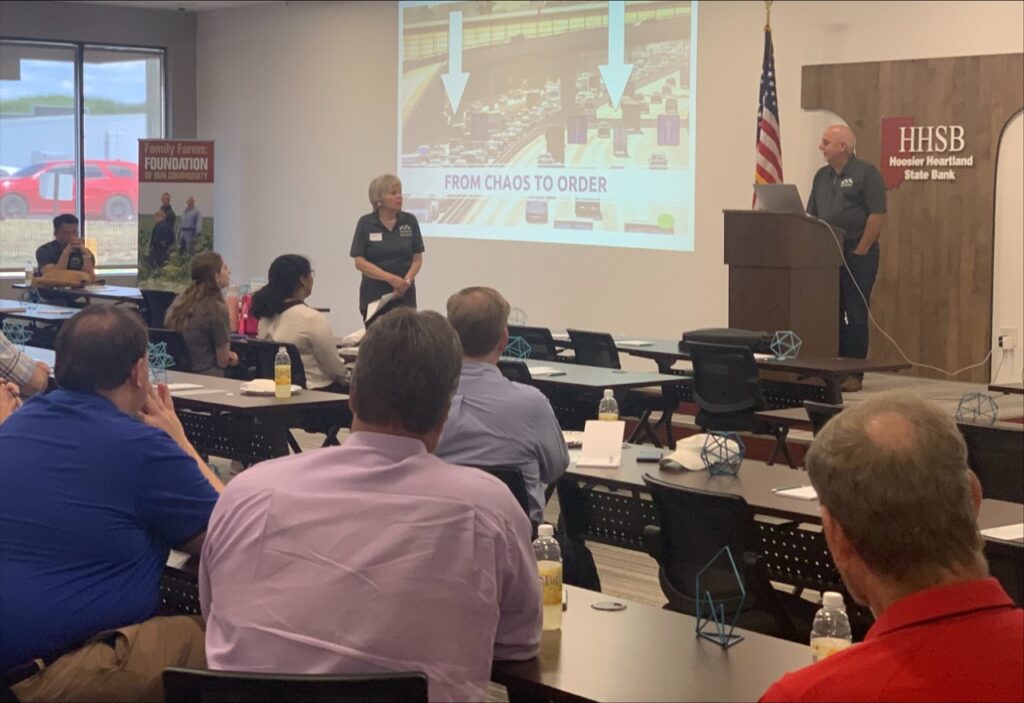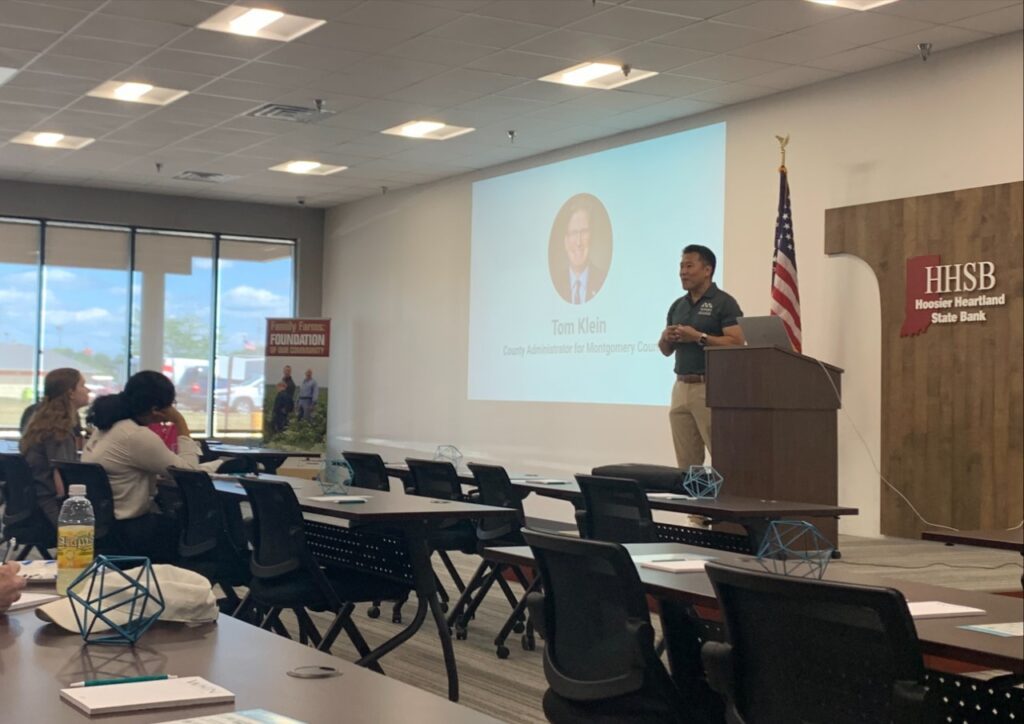Blog
WHIN Touts Record of Success, Offers a Bold Plan for Future


By Joe LaRue
[email protected]
At the HHSB Success Center in Crawfordsville, representatives from local businesses, elected officials, school corporation superintendents and the leadership team at Wabash Heartland Innovation Network (WHIN) gathered for WHIN’s Montgomery County Roadshow. And the WHIN leadership team delivered a bold plan for the future while touting several successful years of innovation and community partnership.
WHIN CEO Johnny Park said in his closing remarks, “What we’re trying to do at WHIN is incredibly ambitious and challenging. Think about developing this region into a global epicenter of digital ag and next-generation manufacturing.”
“It is very ambitious! But we believe we have all the key ingredients to make it happen. Why not us?” he said.
Split into four sections, the presentation covered the diverse array of activities and contributions that WHIN has been involved in and made in Montgomery County in the previous three years. Those include:
- $1,340,393 directly invested in grants, subsidies and staff time;
- $249,045 in industry investments through matching funds, in-kind contributions and partnerships;
- $200,376 in e-learning funds awarded for local schools, which have:
- Served 517 students;
- Provided 352 Chromebooks and iPads for classrooms, including every students at Nicholson Elementary School;
- Equipped 36 school buses with internet hotspots to help athletes and students get a jump on schoolwork and stay connected with family and friends while traveling for school;
- And given 65 MiFi routers to help give rural students access to wireless internets service;
- Providing broadband coverage and resource access to over 12,000 acres of farmland through Ag Alliance;
- Supported 102 Ivy Tech students in agriculture and manufacturing programs that focused on digital agriculture and advanced manufacturing;
- Provided 39% coverage with LoRaWAN systems, which is designed to connect battery-powered devices like weather monitors and grain bin sensors, to the internet;
- 11 weather stations in Montgomery County that have provided more than 28,000,000 weather readings to assist local farmers;
- And 2,205 GB of data collected to assist local ag producers and manufacturers.
So what is WHIN? Testifying to the House Committee on Agriculture on April 20, 2021, CEO Johnny Park offered an explanation: “WHIN is not an Internet Service Provider, and broadband is not our primary business. In fact, we are a 501c3 community organization and our overarching goal is to build a regional ecosystem that can help our rural region attract globally competitive businesses to plant and grow in the Wabash Heartland.” He went on in his testimony to say, “Towards that goal, our principal strategy has been to accelerate the adoption of digital technology in our region, especially digital agriculture and smart manufacturing. As you might expect in Indiana, agriculture and manufacturing are mainstays of our rural economy.”
But WHIN doesn’t focus on simply playing up their brand or making themselves the point-person on projects. Pat Torey, VP of Engagement at WHIN, said in her section of the presentation that, “What we’re trying to do is get all the community stakeholders together, get all the players playing together, leverage our resources and do things faster when we can and help our county grow.”
Torey, along with VP for Broadband Partnerships Greg Jarman, spoke about the importance of the community work WHIN does, focusing on their connections with local school corporations. Torey said, “We’re encouraging schools to be very creative, encouraging e-sports and teachers to use devises to help get synchronous learning.”
Greg Ottinger, VP of Strategic Partnerships, focused on how WHIN was helping to bring newer and better technologies and practices to both farmers and manufacturers through investment and innovation. But the larger point of all of this, at least for WHIN, is about securing a future for the Wabash Heartland Region.
“Our goal is to create jobs for your kids and grandkids,” he said. “Whether they enter right into the workforce, learn a trade or get a college degree, we’re losing kids who move to Indianapolis or Chicago or even further because there are better, higher paying jobs there.”
“You can’t convince everyone to stay, but I know plenty of kids who would love to stay and work and live in Indiana, and we’re hoping to help do that.”
The other member of the WHIN leadership team to speak was Jack Stucky, VP of Engineering. Most of his comments focused on what the new technologies WHIN is helping to proliferate and share do, and he rattled off some impressive facts and figures.
“We have over 185 weather stations in our region, which we believe is one of the densest weather station networks in the county,” he said.
He also pointed out that those 2,205 GB of data collected by WHIN have been instrumental for Purdue and Ivy Tech researchers and students. In fact, that data has been used in research or classes by:
- 50+ researchers at Ivy Tech and Purdue
- And 570+ students at both schools
WHIN is also working to begin two pilot online programs at two high schools in Benton and Fountain counties.
The key idea that was threaded through each of these presentations was the idea of the Living Lab. WHIN, through the partnerships, technology and data gathering, are creating a real-world laboratory for innovation and advancement in the fields of agriculture and manufacturing.
Park, interjecting at the close of Stucky’s remarks, focused on why this Living Lab model is so effective and why they hope it can help be a catalyst for making the Wabash Heartland region a global leader in ag and manufacturing technology.
“That’s real-world data, from real factories and real farms. We have real-time insight into what is happening and what works or doesn’t work,” he said. “That is what is unique; there’s really nothing else like this in the country.”
WHIN is focused upon serving 10 counties: Pulaski, White, Cass, Benton, Carroll, Tippecanoe, Warren, Fountain, Montgomery and Clinton. By promoting smart technology throughout these 10 counties, WHIN is aiming to become the first recognized smart region in the nation.
WHIN was established with a $38,900,000 grant from the Lilly Endowment to help develop the Wabash Heartland Region as a smart community. The endowment is due to expire this year, but stay tuned: WHIN 2.0 is gearing up to take the next steps forward for rural communities across the Wabash Heartland Region.
